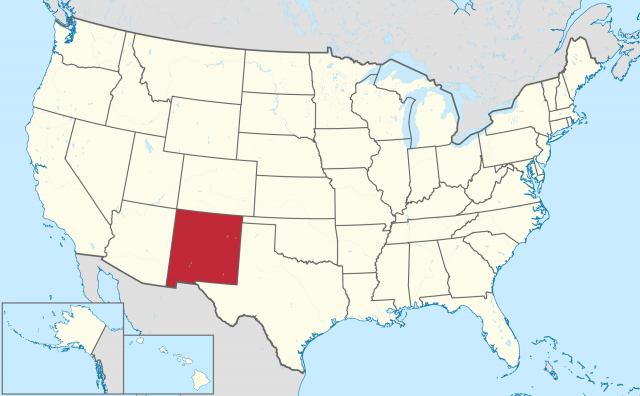New Mexico
NEW MEXICO IS THE “Land of Enchantment.” Nowhere else in the UNITED STATES can such a variety of landscapes, histories, and traditions be found. Located in the American southwest, New Mexico is part of the dry and warm Four Corners region. Although primarily arid in the southern deserts to semi-arid in the high deserts, there are also some pine-studded mountain ranges and High Plains GRASSLANDs. New Mexico is bordered to the north by COLORADO, to the west by ARIZONA, to the south by MEXICO and TEXAS, and to the east by OKLAHOMA and Texas.
The RIO GRANDE flows along a rift valley down the state's center, providing a study of contrasts. From Albuquerque's verdant bosque along the river, one can look east to the snow-capped Sandia mountains or west to dry buttes harboring Anasazi petroglyphs. Capulin, a volcano extinct now for 10,000 years, rises from the ancient beds of this former inland sea. The Malpais (badlands) are lava flows found in several parts of New Mexico. They are are difficult to cross because of the rough rock and are often threaded by lava tubes later used by locals for transportation routes or housing. A visitor can climb up the white gypsum sands of White Sands National Monument and gaze at the uniquely blue skies, or descend deep into the Earth to navigate the dark and winding Carlsbad Caverns.

The Rio Grande is not the only wayfinder through this land. Ancient trails of the Anasazi Indians can still be found in Mesa Verde, Chaco Canyon, and the Aztec ruins. Several trails used by Spanish explorers cross several parts of the state, like the old Santa Fe Trail leading from Independence, MISSOURI to the oldest capital in North America (Santa Fe), and the trail leading to Morro Rock where 17th-century explorers carved their names. Along several valleys are old cattle drive trails used to bring Texas and New Mexican cattle first up to the gold miners of the Rocky Mountains and later to the railroads in Colorado for shipment to the east. Interstate 40 parallels the famous Route 66 that once connected Chicago to Los Angeles.
Histories are made of the interplay between cultures and the landscape they occupy. The first inhabitants of New Mexico were the Anasazi, a collective name for the first indigenous peoples who arrived in the area around 200 C.E. By the time the Spanish arrived in the mid-1500s and established Santa Fe as their capital, numerous Indian tribes lived in New Mexico. The Spanish had established a stronghold before the Anglo migrants from the East arrived. Today New Mexico reveals the results of these migrations as the state incorporates the multi-faceted heritage of the many Indian, Latino, and Anglo cultures.
New Mexico proudly celebrates its many traditions. There is Albuquerque's International Balloon Fiesta, the Inter-Tribal Indian Ceremonial near Gallup, Santa Fe Indian Market, Taos Valley Acequia Festival, and Hatch Valley Chili Festival, among others. New Mexico has long been at the forefront of innovation through the Los Alamos and Sandia labs (nuclear research), very large array (VLA) radio telescope (astronomical research), and the White Sands Missile Range (space flight research). The state has a growing information technology industry and is moving to the forefront in wind and solar power research.